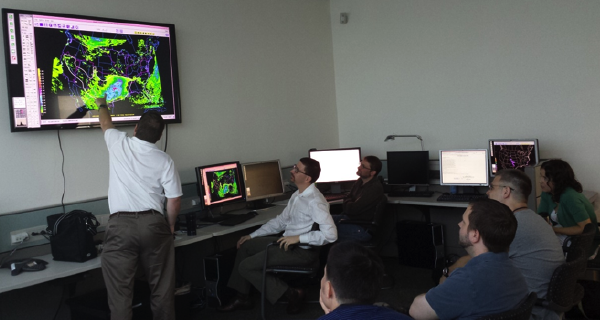HMT-WPC Conducts Second Annual Flash Flood and Intense Rainfall Experiment
October 17, 2014
The Hydrometeorological Testbed at the Weather Prediction Center (HMT-WPC) hosted the second annual Flash Flood and Intense Rainfall (FFaIR) Experiment this summer. This year’s experiment focused on investigating methods to improve flash flood forecasting in the 1 to 36 hour time range.
During the experiment (July 7-25, 2014), 23 participants from the operational forecasting, research, and academic communities used a combination of operational and experimental model data to issue a series of experimental flash flood forecasts. The first was a national 18 hour “flash flood outlook” forecast that was designed to test proposed changes to WPC’s current Excessive Rainfall Outlook. These changes include redefining the product to highlight the probability of flash flooding within 40 km of a point and changing the values of the probability contours. In addition to this national outlook, participants were also asked to issue two short-term probabilistic flash flood outlook forecasts focused on a regional area of interest.
Building off of last year’s success, this year’s experiment again featured the neighborhood probability approach. This approach, which searches for the occurrence of an event within a certain distance of a point, helps account for some of the spatial uncertainty that is inherent in high resolution model forecasts. To address the potential for errors in the expected hydrologic response, this year participants were asked to evaluate the utility of neighborhood probabilities of precipitation exceeding some percentage of flash flood guidance (FFG). Participants found that having access to these different ratios (e.g. QPF > 75% FFG) was valuable as it helped provide additional information about the range of possible forecast solutions.

View the 2014 FFaIR Final Report
Finally, the 2014 FFaIR Experiment featured the debut of a new flash flood verification database. Developed through a partnership between NOAA's Office of Hydrologic Development, WPC, and the National Severe Storms Laboratory (NSSL), this database compiles flash flood observations from NWS Local Storm Reports, NSSL Meteorological Phenomena Identification Near the Ground reports, and stream gauge measurements from the U.S. Geological Survey. This database proved to be extremely valuable and greatly aided in the quality of the subjective evaluations conducted during the experiment.
In the coming months, HMT-WPC will continue to aid WPC’s efforts to redefine the Excessive Rainfall Outlook product while also pursuing enhancements to the flash flood verification database. In addition, HMT-WPC will work with the hydrology community to explore the utility of additional hydrologic datasets for use in the neighborhood probability approach.
Contact: Faye Barthold